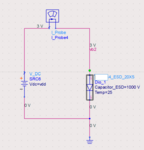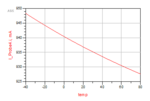coolsummer
Junior Member level 3
Hi all, we know that the pn junction voltage has a negative temperature coefficient. In my test bench, the diode is connected directly to the power supply, which is 3V. Temperature is the variable to sweep and the ic-temp curve is shown below. What puzzles me is: since the diode is connected directly to the power supply, the inner resistor of the diode plays a role, as temperature rises up, the junction voltage of the diode decreases, so the voltage across the inner resistor increases, and the currnet ic should also increase, but the simulation shows that ic decreases according to the temperature. What is wrong with my understanding?


